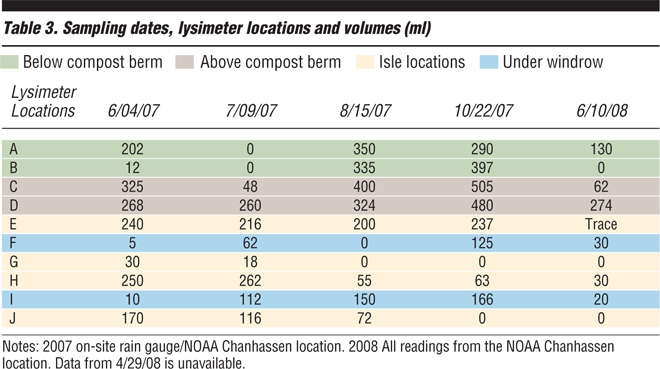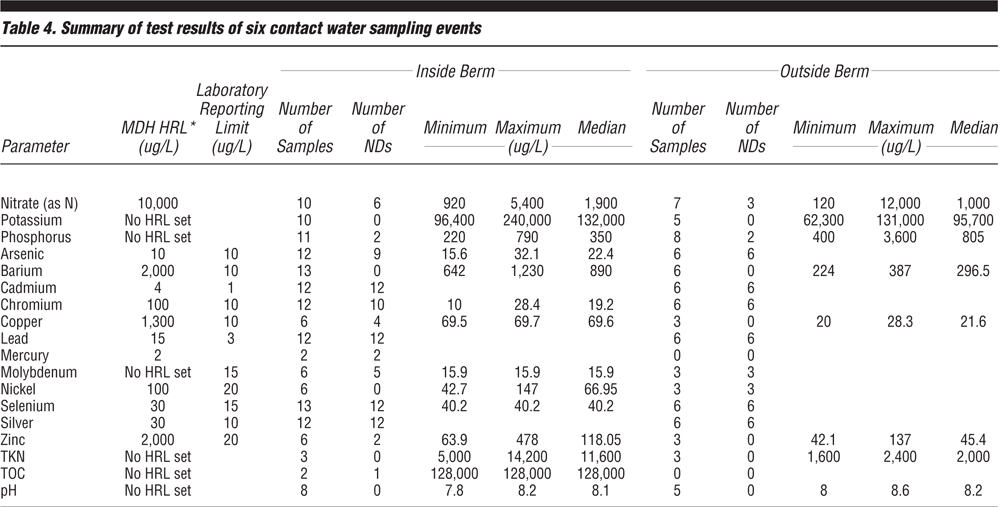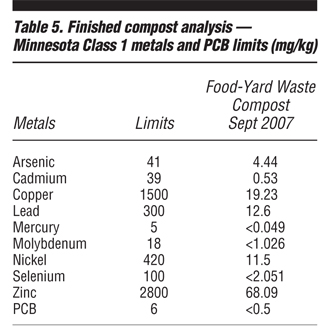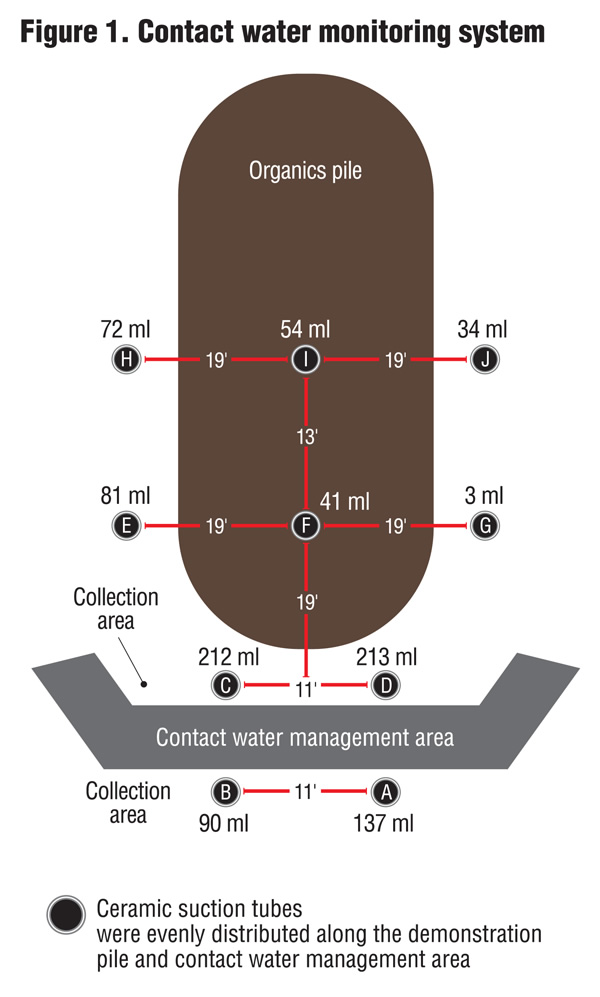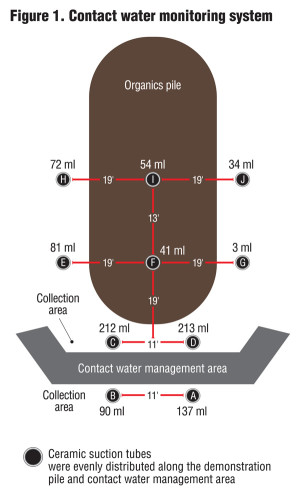The first phase of research at a Minnesota composting site suggests that environmental risk to groundwater is relatively low from addition of source separated organics. Part I
Ginny Black and Marcus Zbinden
BioCycle July 2014
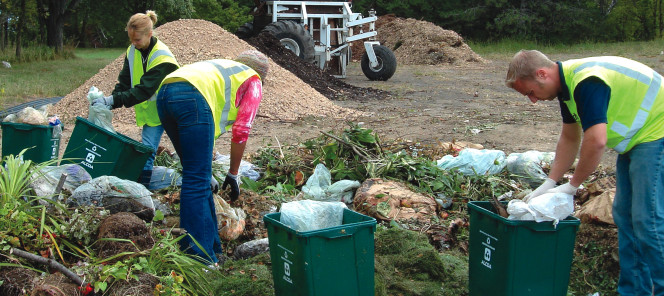
In the residential SSO collection pilot, households were instructed to put food scraps in compostable bags, and place in the cart with yard trimmings and large sized items such as pizza boxes. Photo courtesy of Carver County
Carver County, Minnesota conducted a multiphase research project, funded by the Minnesota Pollution Control Agency (MPCA), on the environmental impacts of composting commingled source separated organics (SSO) and yard trimmings over a span of seven years at two separate sites. A component of all research phases (3 in total) was investigating potential environmental impacts of contact water at source separated composting facilities. Contact water is defined as water that has come into contact with SSO material in the tipping or mixing area or active compost that has not met PFRP requirements. This article is the first in a series presenting the background and results of each project.
In April 2007, Carver County partnered with the University of Minnesota Landscape Arboretum (Arboretum) to obtain a Demonstration Research Permit (DRP) and a $40,000 grant from the MPCA to design and construct a research site at the Arboretum’s existing permit-by-rule yard trimmings composting facility to cocompost residential SSO materials and yard trimmings. A DRP from MPCA allowed utilization of an alternative design to meet the Agency’s policy/research needs. The primary goal of the first research project was to determine if processing SSO at a yard trimmings site can be accomplished without any significant environmental impacts and with only minimal changes in the design and operation of the site. To measure potential impacts from the contact water generated on groundwater, lysimeters were installed to collect subsurface contact water. The second goal of the project was to ascertain if commingled collection and processing of these materials would improve the overall economics of SSO management.
The Arboretum’s composting facility processed all of the yard trimmings from the Arboretum, along with residential yard trimmings. (This site closed and was relocated to its current location on Arboretum property in 2010 as part of the second MPCA grant.) The DPR allowed the addition of SSO to the yard trimmings (YT) already being composted. As the project developed, the MPCA permitted the addition of a large volume of source separated organics from schools and other commercial and industrial sources (see box listing Acceptable/Unacceptable Materials). The DRP allowed 20,000 cubic yards (cy) of YT and SSO on the site at any given time. Composting was performed by RW Farms, the Arboretum’s contractor for the yard trimmings site.
SSO Collection Pilot
Carver County selected Waste Management, Inc. to do the residential SSO collection. Initially, the program was only offered to 570 residential customers. Households continued using their 30, 60 or 90 gallon containers to set out YT and SSO. Due to the volume of YT generated, collection was done weekly from April to November. Utilizing existing collection routes and containers helped keep costs low.
Carver County provided participants with education materials, a kitchen collection container and a supply of compostable bags. Large items such as pizza boxes could go directly into the collection container, while remaining items were required to be placed in compostable bags certified by the Biodegradable Products Institute. The decision to use compostable bags was based on experiences of similar programs within the state and around the country.
As the program became established, the Arboretum converted its cafeteria to almost entirely reusable or compostable items and began diverting all of its SSO to the site. The addition of commercial/institutional SSO, primarily from schools, began in Fall 2007, which led to a substantial increase in volumes. The facility continued to compost YT and commingled YT and SSO from the residential collection, as well as processed brush. However, greater quantities of YT were necessary to mix with the larger volume of SSO.
The program continued to grow as Waste Management added SSO collection to YT routes in three additional cities. Carver County also added a drop-off site for SSO at the County’s Environmental Center. In April 2008, an independent hauler began a similar SSO cocollection program in a southwest metro area and started delivering the material to the Arboretum site.
SSO Program Evaluation
Several issues were identified during the project. First, cocollection of SSO with YT made it difficult to quantify the amount of SSO being collected. To get a handle on the generation of SSO from residential routes, Carver County conducted several waste sorts and weighed incoming loads at the composting site by utilizing a scale installed on the Supreme mixer. Table 1 shows that for 2007/08, a total of 33,288 cubic yards of organics were delivered to the site. Of that, 74 percent was grass, leaves and brush and 26 percent was SSO. (During the first two years of the demonstration project — 2007 and 2008 — volumes remained relatively low but by 2010, the site processed 60,000 cubic yards.)
The second issue identified was collection frequency. In Minnesota, YT collection services typically are offered weekly during the growing season from April to November. This corresponds nicely with the need to collect SSO frequently during that time period to avoid odors. However, YT collection service is not offered from December through March. To avoid a gap in SSO collection service, Carver County worked with Waste Management to offer winter collection. (Waste Management was the only hauler that Carver County worked with as part of the MPCA grant. Other residential haulers began using the site in 2009 once the was grant project was completed.) The lack of YT generation during these months made the option of every other week collection possible. However, concerns were voiced that moving away from weekly collection could create odor issues and that colder temperatures could cause the SSO to freeze to the containers.
To answer these questions, the MPCA increased grant funding in 2007 by $15,000 to test collection frequencies during winter months. Results indicated that every other week collection during the winter did not result in undue odor issues and the SSO did not freeze to the collection containers. Also, offering biweekly collection in the winter months helped minimize the cost of hauling. These finding helped haulers in their decision making process to offer year round SSO collection service.
Water Quality Measuring Methods
The research site at the Arboretum was approximately 4 acres in size with a pad that consisted of 6 inches of compacted Class V gravel with a 3 percent slope over native loam soils. According to the U.S. Geological survey, the water table was located at 78 inches. The experimental method was designed to capture contact water through the use of 10 ceramic collection suction tubes known as lysimeters, placed underneath and surrounding the active composting pile. The lysimeters were buried at a depth of 36 inches and placed under negative pressure to allow for the collection of contact water that infiltrated into the surrounding subsoils. Figure 1 shows the location of the lysimeters. Four (E and H, G and J) were located in the aisles and would be fully exposed to any precipitation that fell on the compost pad, two (F and I) were located under the compost pile, and four were located by the compost filter berm — two up gradient of the berm (C and D) and two down gradient (A and B). The lysimeters down gradient of the berm were installed to measure the effectiveness of the berm in treating contact water before it leaves the site.
Samples collected the first year were analyzed for pH, nitrate, phosphorus, potassium, and the standard metals panel (USEPA Part 503 metals, plus chromium and silver). In 2008, MPCA requested additional parameters be sampled in the second year. The additional parameters included mercury, molybdenum, nickel, selenium, silver, zinc, Total Kjeldhal Nitrogen (TKN), and total organic carbon (TOC). Sample collection took place after rainfall events of 0.5 inches or greater from April through November, as the remainder of the year the ground is frozen and infiltration of contact water into the subsoils was not possible.
Test results from all sample events were compared to the Minnesota Department of Health’s (MDH) Health Risk Limits (HRL) for drinking water. The drinking water standards are based on a filter water test whereas all of the water samples from the Arboretum composting site are readings from unfiltered water samples. Filtered water samples will often have lower metal concentrations because sediments and organics are reduced by the filtering process. The experimental method used for this project does bring up an interesting question of standardized test methods for contact water generated at composting sites. To date, there are no standards, which is why it was decided to use the most conservative drinking water standard for comparison.
Noncontrollable Factors
When using applied science for a research project there are always a number of factors that cannot be controlled. One of these is weather. During the course of the research project, precipitation varied from drought conditions to wetter than normal. Table 2 shows average rainfall during the months when samples were collected, the deviation from the average rainfall for each month, and the amount of rain that fell 7 days prior to the sampling event. The lack of precipitation in some months, along with the fact that most water generated at the site was converted to run-off, resulted in very little contact water infiltrating through the 6-inch compacted Class V gravel pad into the loam subsoils. Because of the lack of sample volume, it was not always possible to test for all parameters.
A second factor affecting sampling was operational practices at a composting site. Table 3 shows the location and average volumes found in each lysimeter from the 30 rain events sampled over the two-year sampling period. The lowest average volumes of contact water are found in lysimeters F, G, I and J. This suggests that the compost pile was constructed primarily over lysimeters G and J — and as the pile expanded, covered lysimeters F and I.
Based on observation and field notes from the six sampling events, it was determined that when the lysimeters were covered with the compost pile no contact water was found. The lack of water in the lysimeters below the compost pile suggests that there was no vertical movement of contact water through the compost pile, the Class V pad and into the lysimeters in the subsoils below.
Water Quality Data
Table 4 summarizes results of the six contact water sampling events, along with a comparison to the MDH HRL for drinking water. The sampling is viewed from the perspective of contact water generated on the site and then after it has been filtered by the compost berm.
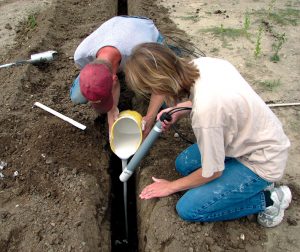
Contact water was captured through use of 10 ceramic collection suction tubes known as lysimeters placed underneath and surrounding the active composting pile (lysimeter installation shown in photo). Photo courtesy of Carver County
Samples were tested for the metals panel. For most samples, the NPK and pH was also tested. However, enough liquid was not always available to test for all constituents. Up gradient of the berm, the maximum number of samples was 13. Based on the amount of liquid available for sampling, the number of test results ranged from 2 to 13.
Of the metals panel, arsenic, nickel and selenium had hits that exceeded the HRL for drinking water. The contact water generated up gradient of the compost berm showed the following composition:
Arsenic: The HRL for arsenic is 10 µg/L and of the 12 samples, nine were nondetect and three readings were above the standard — 22.4 µg/L, 15.6 µg/L, and 32.1 µg/L respectively. On further investigation, it was found that the native soils at this site contain high level of arsenic. Two separate soil samples were taken at 0 to 6 inches, 6 to 12 inches, 12 to 18 inches and 18 to 24 inches. The arsenic levels at or below the 12- to 18-inch depths were assumed to be naturally occurring arsenic as they are below the level of biologically active topsoil. Those levels ranged from 5.87 to 12.09 mg/kg. These high levels are believed to have contributed to the high levels of arsenic in the subsurface water samples.
Nickel: Nickel was sampled 6 times; of those, one test was above the HRL for drinking water. The HRL is 100 µg/L and the test result was 147 µg/L. All other test results were below the HRL. The median value for nickel was 66.9 µg/L.
Selenium: Selenium was analyzed in 13 samples. Of those, one test was above the HRL for drinking water. The HRL for selenium is 30 µg/L and the test result exceeding the standard was 40.2 µg/L. All other test results were below the detection limit.
All other metals test results up gradient of the berm were either nondetect, or well below the HRL set for that metal.
Up gradient of the berm, 10 samples were tested for nitrates and potassium and 11 for phosphorus. Of these three nutrients, only nitrates has a HRL set at 10,000 µg/L. None of the test results exceeded the HRL for nitrates.
Down gradient of the berm, all samples of arsenic, cadmium, chromium, lead, mercury, molybdenum, nickel, selenium, and silver were below detection levels. However, there were two noteworthy test results. A single sample of the nitrate exceeded the HRL and one of the phosphorus values was significantly higher than the up gradient values. The nitrate test result was 12,000 µg/L; the HRL is 10,000 µg/L. However the mean results were 1,000 µg/L far below the standard. The phosphorus test result was 3,600 µg/L, with a mean of 805 µg/L. The MDH has not set HRLs for phosphorus. Overall, of the median concentrations for those constituents samples were reduced significantly. Reductions were as follows: Nitrates-47.4%; potassium-27.5%, barium-66%; copper- 69%; TKN-82.7%; and zinc- 61.5%. The exception was phosphorus with a median level of increase by 230%.
No parameters sampled down gradient of compost filter berm (after filtrations) exceeded the HRLs set by the state Department of Health. The component of the project that evaluated the effectiveness of compost berms in treating contact water suggests the several parameters tested did significantly decrease after treatment.
Finished Compost Test Results
The final objective of the project was to test the finished compost resulting from the yard trimmings-source separated organics compost. Minnesota requires that only the USEPA Part 503 metals and maturity be tested to determine if the compost meets MPCA’s standards for Class I compost. Maturity testing was conducted using the Solvita test method and performed on November 13 and November 15, 2007. Those test result were a 6 and 7 on the Solvita scale, meeting the maturity standards. Table 5 shows the state’s metals limits and the test results from the YT-SSO compost. All results were far below the standards.
Overall Findings
The cocollection of SSO with the yard trimmings program was well received by Carver County residents with a greater than 25 percent participation rate at program start up. This exceeded the participation rates that traditional recycling programs received when first introduced.
Conducting research at an operating composting facility provides challenges, but the advantages is it utilized natural rain events and provided a representative sample of contact water generated on an SSO site. However, environmental impact from this research can only be considered as indicators of what is occurring at a source separated composting facility. While the data collected suggests that environmental risk to ground water is relatively low, more research is needed to get a thorough understanding of the chemical composition of contact water from SSO composting sites.
Ginny Black, formerly an Organics Recycling Specialist with the Minnesota Pollution Control Agency, is Chair of the Minnesota Composting Council. She also serves as Treasurer of the Composting Council Research and Education Foundation. Marcus Zbinden works for Carver County as an Environmental Specialist and is Vice Chair of the Minnesota Composting Council and Chair of the Recycling Association of Minnesota.


